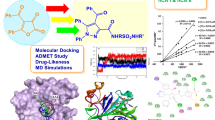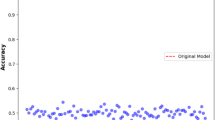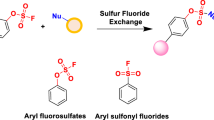Abstract
HSP90 is a major molecular chaperone that helps both folding and stabilization of various client proteins often implicated in growth control and cell survival such as kinases and transcription factors. However, among HSP90 clients are also found numerous oncoproteins and, through its assistance to them, HSP90 has consequently been reported as a promising anticancer target. Several ligand chemotypes, including resorcinol type ligands, were found to inhibit HSP90, most of them in an ATP competitive manner. Binding of some of these ligands modify significantly the NMR spectrum of the HSP90 ATP binding domain compared to the apo protein spectrum, hampering assignment transfer from the previously assigned human HSP90 apo state. Here we report the assignment of the 1HN, 15N, 13C′, 13Cα, 13Cβ, 1Hmethyl, and 13Cmethyl chemical shifts of the 29 kDa HSP90 N-terminal domain bound to a long residence time resorcinol type inhibitor: 5-[4-(2-Fluoro-phenyl)-5-oxo-4,5-dihydro-1H-[1,2,4]triazol-3-yl]-N-furan-2-ylmethyl-2,4-dihydroxy-N-methyl-benzamide. 92% of the backbone resonances and 100% of the [1H, 13C]-resonances of Aβ, Mε, Tγ, Lδ2, Vγ2 and Iδ1 methyl groups were successfully assigned, including for the first time the assignment of the segment covering the nucleotide/drug binding site. Secondary structure predictions based on the NMR assignment reveal a structural rearrangement of HSP90 N-terminal domain upon ligand binding. The long residence time ligand induces the formation of a continuous helix covering the ligand binding site of HSP90 N-terminal domain accounting for the large differences observed in the NMR spectra between the apo and bound proteins.




Similar content being viewed by others
References
Amaral M, Kokh DB, Bomke J et al (2017) Protein conformational flexibility modulates kinetics and thermodynamics of drug binding. Nat Commun. https://doi.org/10.1038/s41467-017-02258-w
Amero C, Schanda P, Asunción Durá M et al (2009) Fast two-dimensional NMR spectroscopy of high molecular weight protein assemblies. J Am Chem Soc 131:3448–3449. https://doi.org/10.1021/ja809880p
Amero C, Asunción Durá M, Noirclerc-Savoye M et al (2011) A systematic mutagenesis driven strategy for siteresolved NMR studies of supramolecular assemblies. J Biomol NMR 50:229–236. https://doi.org/10.1007/s10858-011-9513-5
Ayala I, Sounier R, Usé N et al (2009) An efficient protocol for the complete incorporation of methyl-protonated alanine in perdeuterated protein. J Biomol NMR 43:111–119. https://doi.org/10.1007/s10858-008-9294-7
Ayala I, Hamelin O, Amero C et al (2012) An optimized isotopic labelling strategy of isoleucine-γ2 methyl groups for solution NMR studies of high molecular weight proteins. Chem Commun 48:1434–1436. https://doi.org/10.1039/c1cc12932e
Bardwell JC, Craig EA (1987) Eukaryotic Mr 83,000 heat shock protein has a homologue in Escherichia coli. Proc Natl Acac Sci USA 84:5177–5181. https://doi.org/10.1073/pnas.84.15.5177
Borkovich KA, Farrelly FW, Finkelstein DB et al (1989) hsp82 is an essential protein that is required in higher concentrations for growth of cells at higher temperatures. Mol Cell Biol 9:3919–3930. https://doi.org/10.1128/mcb.9.9.3919
Calderwood SK, Khaleque MA, Sawyer DB, Ciocca DR (2006) Heat shock proteins in cancer: chaperones of tumorigenesis. Trends Biochem Sci 31:164–172. https://doi.org/10.1016/j.tibs.2006.01.006
Chant ID, Rose PE, Morris AG (1995) Analysis of heat-shock protein expression in myeloid leukaemia cells by flow cytometry. Br J Huematol. https://doi.org/10.1111/j.1365-2141.1995.tb03395.x
Ciocca DR, Calderwood SK (2005) Heat shock proteins in cancer: diagnostic, prognostic, predictive, and treatment implications. Cell Stress Chaperones 10:86–103. https://doi.org/10.1379/csc-99r.1
Crublet E, Kerfah R, Mas G et al (2014) A cost-effective protocol for the parallel production of libraries of CH3-specifically labeled mutants for NMR studies of high molecular weight proteins. Methods Mol Biol 1091:229–243. https://doi.org/10.1007/978-1-62703-691-7_17
Csermely P, Schnaider T, Soti C et al (1998) The 90-kDa molecular chaperone family: structure, function, and clinical applications. Compr Rev Pharmacol Ther 79:129–168. https://doi.org/10.1016/s0163-7258(98)00013-8
Daturpalli S, Waudby CA, Meehan S, Jackson SE (2013) Hsp90 inhibits α-synuclein aggregation by interacting with soluble oligomers. J Mol Biol 425:4614–4628. https://doi.org/10.1016/j.jmb.2013.08.006
Delaglio F, Grzesiek S, Vuister GW et al (1995) NMRPipe: a multidimensional spectral processing system based on UNIX pipes. J Biomol NMR 6:277–293. https://doi.org/10.1007/BF00197809
Farrelly FW, Finkelstein DB (1984) Complete sequence of the heat shock-inducible HSP90 gene of Saccharomyces cerevisiae. J Biol Chem 259:5745–5751. https://doi.org/10.1016/s0021-9258(18)91077-x
Favier A, Brutscher B (2019) NMRlib: user-friendly pulse sequence tools for bruker NMR spectrometers. J Biomol NMR 73:199–211. https://doi.org/10.1007/s10858-019-00249-1
Garg G, Khandelwal A, Blagg BSJ (2016) Anticancer inhibitors of Hsp90 function: beyond the usual suspects. Adv Cancer Res 129:51–88. https://doi.org/10.1016/bs.acr.2015.12.001
Hanahan D, Weinberg RA (2011) Hallmarks of cancer: the next generation. Cell 144:646–674. https://doi.org/10.1016/j.cell.2011.02.013
Henot F, Kerfah R, Törner R et al (2021) Optimized precursor to simplify assignment transfer between backbone resonances and stereospecifically labelled valine and leucine methyl groups: application to human Hsp90 N-terminal domain. J Biomol NMR 75:221–232. https://doi.org/10.1007/s10858-021-00370-0
Henot F, Rioual E, Favier A et al (2022) Visualizing the transiently populated closed-state of human HSP90 ATP binding domain. bioRxiv. https://doi.org/10.1101/2022.03.16.484593
Hoter A, El-Sabban ME, Naim HY (2018) The HSP90 family: structure, regulation, function, and implications in health and disease. Int J Mol Sci. https://doi.org/10.3390/ijms19092560
Jacobs DM, Langer T, Elshorst B et al (2006) NMR backbone assignment of the N-terminal domain of human HSP90. J Biomol NMR 36:52. https://doi.org/10.1007/s10858-006-9030-0
Jameel A, Skilton RA, Campbell TA et al (1992) Clinical and biological significance of HSP89 alpha in human breast cancer. Int J Cancer 50:409–415. https://doi.org/10.1002/ijc.2910500315
Johnson JL (2012) Evolution and function of diverse Hsp90 homologs and cochaperone proteins. Biochim Biophys Acta 1823:607–613. https://doi.org/10.1016/j.bbamcr.2011.09.020
Li J, Soroka J, Buchner J (2012) The Hsp90 chaperone machinery: conformational dynamics and regulation by co-chaperones. Biochim Biophys Acta 1823:624–635. https://doi.org/10.1016/j.bbamcr.2011.09.003
Mas G, Crublet E, Hamelin O et al (2013) Specific labeling and assignment strategies of valine methyl groups for NMR studies of high molecular weight proteins. J Biomol NMR 57:251–262. https://doi.org/10.1007/s10858-013-9785-z
McCarthy MM, Pick E, Kluger Y et al (2008) HSP90 as a marker of progression in melanoma. Ann Oncol 19:590–594. https://doi.org/10.1093/annonc/mdm545
Meng X, Devin J, Sullivan WP et al (1996) Mutational analysis of Hsp90α dimerization and subcellular localization: dimer disruption does not impede ‘in vivo’ interaction with estrogen receptor. J Cell Sci 109:1677–1687
Meyer P, Prodromou C, Hu B et al (2003) Structural and functional analysis of the middle segment of Hsp 90: implications for ATP hydrolysis and client protein and cochaperone interactions. Mol Cell 11:647–658. https://doi.org/10.1016/s1097-2765(03)00065-0
Millson SH, Truman AW, Rácz A et al (2007) Expressed as the sole Hsp90 of yeast, the α and β isoforms of human Hsp90 differ with regard to their capacities for activation of certain client proteins, whereas only Hsp90β generates sensitivity to the Hsp90 inhibitor radicicol. FEBS J 274:4453–4463. https://doi.org/10.1111/j.1742-4658.2007.05974.x
Miyata Y, Yahara I (1992) The 90-kDa heat shock protein, HSP90, binds and protects casein kinase II from self-aggregation and enhances its kinase activity. J Biol Chem 267:7042–7047. https://doi.org/10.1016/s0021-9258(19)50533-6
Miyata Y, Nakamoto H, Neckers L (2012) The therapeutic target Hsp90 and cancer hallmarks. Curr Pharm Des 19:347–365. https://doi.org/10.2174/138161213804143725
Monneau YR, Rossi P, Bhaumik A et al (2017) Automatic methyl assignment in large proteins by the MAGIC algorithm. J Biomol NMR 69:215–227. https://doi.org/10.1007/s10858-017-0149-y
Nemoto T, Ohara-Nemoto Y, Ota M et al (1995) Mechanism of dimer formation of the 90-kDa heat-shock protein. Eur J Biochem 233:1–8. https://doi.org/10.1111/j.1432-1033.1995.001_1.x
Ogata M, Naito Z, Tanaka S et al (2000) Overexpression and localization of heat shock proteins mRNAin pancreatic carcinoma. J Nippon Med Sch 67:177–185. https://doi.org/10.1272/jnms.67.177
Park SJ, Kostic M, Dyson HJ (2011) Dynamic interaction of Hsp90 with its client protein p53. J Mol Biol 411:158–173. https://doi.org/10.1016/j.jmb.2011.05.030
Pearl LH, Prodromou C (2006) Structure and mechanism of the Hsp90 molecular chaperone machinery. Annu Rev Biochem 75:271–294. https://doi.org/10.1146/annurev.biochem.75.103004.142738
Picard HSP90 INTERACTORS Chaperones and relatives. http://www.picard.ch/downloads/Hsp90interactors.pdf. Accessed 13 Oct 2021
Prodromou C, Roe SM (1997) Identification and structural characterization of the ATP/ADP-binding site in the Hsp90 molecular chaperone. Cell 90:65–75. https://doi.org/10.1016/s0092-8674(00)80314-1
Röhl A, Rohrberg J, Buchner J (2013) The chaperone Hsp90: changing partners for demanding clients. Trends Biochem Sci 38:253–262. https://doi.org/10.1016/j.tibs.2013.02.003
Shen Y, Delaglio F, Cornilescu G, Bax A (2009) TALOS+: a hybrid method for predicting protein backbone torsion angles from NMR chemical shifts. J Biomol NMR 44:213–223. https://doi.org/10.1007/s10858-009-9333-z
Song HY, Dunbar JD, Zhang YX et al (1995) Identification of a protein with homology to hsp90 that binds the type 1 tumor necrosis factor receptor. J Biol Chem 270:3574–3581. https://doi.org/10.1074/jbc.270.8.3574
Sorger PK, Pelham HR (1987) The glucose-regulated protein grp94 is related to heat shock protein hsp90. J Mol Biol 194:341–344. https://doi.org/10.1016/0022-2836(87)90380-9
Taipale M, Jarosz DF, Lindquist S (2010) HSP90 at the hub of protein homeostasis: emerging mechanistic insights. Nat Rev Mol Cell Biol 11:515–528. https://doi.org/10.1038/nrm2918
Törner R, Awad R, Gans P et al (2020) Spectral editing of intra- and inter-chain methyl–methyl NOEs in protein complexes. J Biomol NMR 74:83–94. https://doi.org/10.1007/s10858-019-00293-x
Trepel J, Mollapour M, Giaccone G, Neckers L (2010) Targeting the dynamic HSP90 complex in cancer. Nat Rev Cancer 10:537–549. https://doi.org/10.1038/nrc2887
Tugarinov V, Kay LE (2003) Ile, Leu, and Val methyl assignments of the 723-residue malate synthase G using a new labeling strategy and novel NMR methods. J Am Chem Soc 125:13868–13878. https://doi.org/10.1021/ja030345s
Tugarinov V, Kay LE, Ibraghimov I, Orekhov VY (2005) High-resolution four-dimensional 1H–13C NOE spectroscopy using methyl-TROSY, sparse data acquisition, and multidimensional decomposition. J Am Chem Soc 127:2767–2775. https://doi.org/10.1021/ja044032o
Vartholomaiou E, Echeverría P, Picard D (2016) Unusual suspects in the twilight zone between the Hsp90 interactome and carcinogenesis. Adv Cancer Res 129:1–30. https://doi.org/10.1016/bs.acr.2015.08.001
Vranken WF, Boucher W, Stevens TJ et al (2005) The CCPN data model for NMR spectroscopy: development of a software pipeline. Prot Struct Funct Genet 59:687–696. https://doi.org/10.1002/prot.20449
Wang L, Zhang Q, You Q (2021) Targeting the HSP90–CDC37–kinase chaperone cycle: a promising therapeutic strategy for cancer. Med Res Rev. https://doi.org/10.1002/med.21807
Whitesell L, Lindquist SL (2005) HSP90 and the chaperoning of cancer. Nat Rev Cancer 5:761–772. https://doi.org/10.1038/nrc1716
Yufu Y, Nishimura J, Nawata H (1992) High constitutive expression of heat shock protein 90α in human acute leukemia cells. Leuk Res 16:597–605. https://doi.org/10.1016/0145-2126(92)90008-U
Yuno A, Lee MJ, Lee S et al (2018) Clinical evaluation and biomarker profiling of Hsp90 inhibitors. Methods Mol Biol 1709:423–441. https://doi.org/10.1007/978-1-4939-7477-1_29
Zuehlke A, Johnson JL (2010) Hsp90 and co-chaperones twist the functions of diverse client proteins. Biopolymers 93:211–217. https://doi.org/10.1002/bip.21292
Zuehlke AD, Moses MA, Neckers L (2018) Heat shock protein 90: Its inhibition and function. Philos Trans R Soc Lond B. https://doi.org/10.1098/rstb.2016.0527
Acknowledgements
The authors thank Drs. P. Macek, P. Gans, R. Awad and R. Kerfah for advice and stimulating discussions. This work used the high field NMR and isotopic labelling facilities at the Grenoble Instruct-ERIC Center (ISBG; UAR 3518 CNRS-CEA-UGA-EMBL) within the Grenoble Partnership for Structural Biology (PSB). Platform access was supported by FRISBI (ANR-10-INBS-05-02) and GRAL, a project of the University Grenoble Alpes graduate school (Ecoles Universitaires de Recherche) CBH-EUR-GS (ANR-17-EURE-0003). IBS acknowledges integration into the Interdisciplinary Research Institute of Grenoble (IRIG, CEA). This work was supported by grants from CEA/NMR-Bio (research program C24990), by the French National Research Agency in the framework of the "Investissements d’avenir” program (ANR‐15‐IDEX‐02) and by a fellowship (to F.H.) from “La Ligue contre le Cancer”.
Author information
Authors and Affiliations
Contributions
FH, MF and JB: designed the experiments; EC and FH: prepared the samples; FH and JB: collected the NMR experiments; FH: analyzed the experiments; FH and JB: wrote the manuscript. All authors discussed the results, corrected the manuscripts and approved the final version.
Corresponding authors
Ethics declarations
Conflict of interest
The authors declare no competing interests.
Additional information
Publisher's Note
Springer Nature remains neutral with regard to jurisdictional claims in published maps and institutional affiliations.
Rights and permissions
About this article
Cite this article
Henot, F., Crublet, E., Frech, M. et al. NMR assignment of human HSP90 N-terminal domain bound to a long residence time resorcinol ligand. Biomol NMR Assign 16, 257–266 (2022). https://doi.org/10.1007/s12104-022-10089-0
Received:
Accepted:
Published:
Issue Date:
DOI: https://doi.org/10.1007/s12104-022-10089-0




